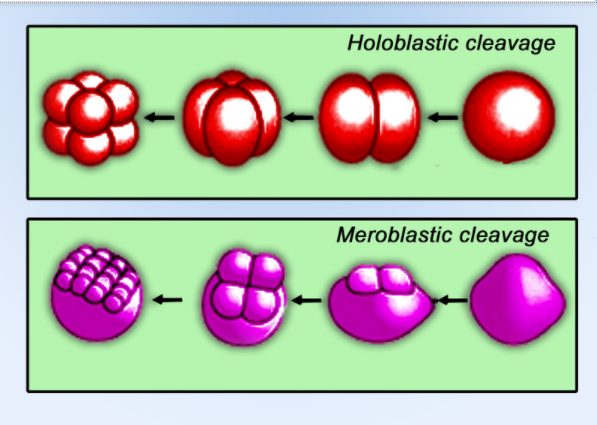
Answer
442.2k+ views
Hint: Cleavage is a process that occurs in the embryo after fertilization. The cells formed after the division of the zygote are known as blastomeres. The extent and type of cleavage depends on the type of species it belongs to, the amount of yolk present, and its fate.
Complete answer:
- In holoblastic cleavage, the zygote is completely divided into two blastomeres. It is also known as total or entire cleavage.
- The blastomeres formed by the division may be equal or unequal in size.
- The types of holoblastic cleavage are bilateral, radial, rotational, and spiral.
Additional Information:
- Equatorial cleavage occurs when the cleavage furrow passes through the cell’s midsection.
- Radial cleavage is a type of holoblastic cleavage where the axes are parallel or at right angles to the polar axis of the egg cell. The blastomeres are arranged in a radial symmetry where the upper tier lies directly over the lower tier.
- Meroblastic cleavage occurs due to a large amount of yolk present in the egg. The cleavage furrow does not divide the egg completely and hence it is a partial cleavage.
So, the correct answer is ‘Holoblastic’.

Note: - Meroblastic cleavage is of two types - discoidal and superficial.
- Zygotes of many species undergo multiple cell cycles but do not undergo any growth initially so the mass of the cells is the same size as the original cell. The compact mass of cells is called the morula.
- The process of cleavage ends with the formation of blastula.
Complete answer:
- In holoblastic cleavage, the zygote is completely divided into two blastomeres. It is also known as total or entire cleavage.
- The blastomeres formed by the division may be equal or unequal in size.
- The types of holoblastic cleavage are bilateral, radial, rotational, and spiral.
Additional Information:
- Equatorial cleavage occurs when the cleavage furrow passes through the cell’s midsection.
- Radial cleavage is a type of holoblastic cleavage where the axes are parallel or at right angles to the polar axis of the egg cell. The blastomeres are arranged in a radial symmetry where the upper tier lies directly over the lower tier.
- Meroblastic cleavage occurs due to a large amount of yolk present in the egg. The cleavage furrow does not divide the egg completely and hence it is a partial cleavage.
So, the correct answer is ‘Holoblastic’.

Note: - Meroblastic cleavage is of two types - discoidal and superficial.
- Zygotes of many species undergo multiple cell cycles but do not undergo any growth initially so the mass of the cells is the same size as the original cell. The compact mass of cells is called the morula.
- The process of cleavage ends with the formation of blastula.
Recently Updated Pages
Identify the feminine gender noun from the given sentence class 10 english CBSE

Your club organized a blood donation camp in your city class 10 english CBSE

Choose the correct meaning of the idiomphrase from class 10 english CBSE

Identify the neuter gender noun from the given sentence class 10 english CBSE

Choose the word which best expresses the meaning of class 10 english CBSE

Choose the word which is closest to the opposite in class 10 english CBSE

Trending doubts
Which are the Top 10 Largest Countries of the World?

Fill the blanks with the suitable prepositions 1 The class 9 english CBSE

How do you graph the function fx 4x class 9 maths CBSE

A rainbow has circular shape because A The earth is class 11 physics CBSE

The male gender of Mare is Horse class 11 biology CBSE

One Metric ton is equal to kg A 10000 B 1000 C 100 class 11 physics CBSE

Change the following sentences into negative and interrogative class 10 english CBSE

Give 10 examples for herbs , shrubs , climbers , creepers

The Equation xxx + 2 is Satisfied when x is Equal to Class 10 Maths




